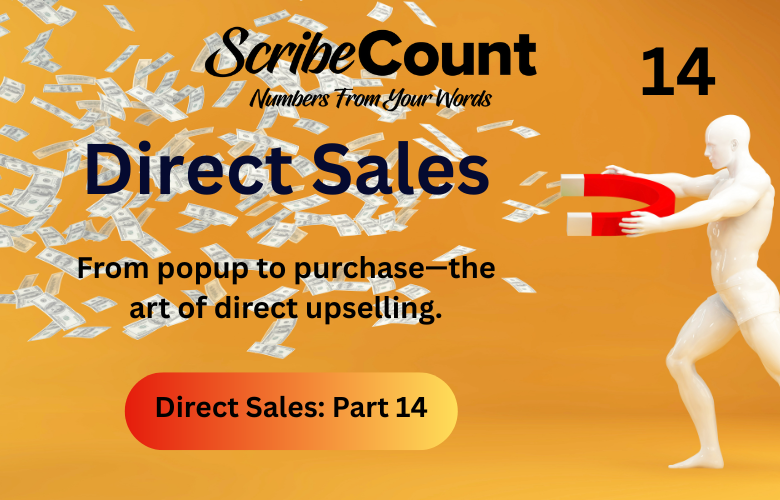Popups, Cross-Selling, and Upsells in Your Author Store: How to Increase Order Value Without Annoying Readers
Selling a single book is great. Selling two or more is better. That’s where popups, upsells, cross-sells, and coupons come into play. These tools are standard in ecommerce—and they’re just as valuable for indie authors looking to grow their direct sales income.
When a reader clicks "Add to Cart," they’re already saying yes to you. Your job is to gently offer them a reason to say yes again. Maybe it’s a discounted bundle. Maybe it’s an exclusive short story. Maybe it’s free shipping if they cross a price threshold. These aren’t tricks—they’re invitations. Done right, they increase your average order value (AOV), reward the reader, and make your store feel curated, not cluttered.
Popups: When and Why to Use Them
Popups can annoy readers—but they don’t have to. The key is timing, relevance, and value. Consider using popups in the following ways:
- Exit-intent: When someone moves their mouse to close the tab, show a popup offering a discount or reminder.
- Time-based: After 30–60 seconds on the product page, offer a bundle or free chapter.
- Scroll-based: When a user scrolls 50–75% down, offer a preorder bonus.
- Cart-triggered: When a book is added to the cart, suggest a related title.
Popups should always offer something meaningful—bonus content, limited-time deals, or insider access. Avoid intrusive designs. Keep the language warm, brief, and benefit-driven.
Use tools like Privy or OptiMonk on Shopify, or Popup Maker for WooCommerce.
Cross-Selling: "You Might Also Like"
Cross-selling is about showing readers items that complement their current selection. If someone adds a thriller to their cart, offer the prequel. If they’re buying Book One, show Book Two.
You can cross-sell:
- Series continuations
- Matching merch
- Audiobook editions
- Bookplates or signed versions
Cross-sells can live in the cart, below the product description, or even on the thank-you page. Make them visual, simple, and closely related to what the reader already wants.
Use ReConvert (Shopify) or Product Recommendations (WooCommerce) to automate suggestions.
Upselling: Upgrade the Experience
Upselling is about replacing what’s in the cart with a higher-value option. Think:
- Paperback → Signed paperback
- eBook → eBook + audiobook bundle
- One book → Series box set
You can use upsells on the product page, in-cart, or after purchase via email. The best upsells offer obvious added value for a reasonable increase in price. Don’t overdo it—one great offer outperforms five cluttered ones.
Upsells can also be seasonal. During a launch week or sale, offer special edition bundles or launch-exclusive formats.
Coupons and Strategic Discounts
Coupons can be a powerful motivator when used sparingly and strategically. Rather than blanket discounts, offer conditional or time-sensitive codes that reward reader behavior.
For example, give a coupon code for free shipping on orders over $50, or 10% off for newsletter subscribers. Use discounts as rewards—“Thanks for being a VIP!”—instead of bribes—“Please don’t leave!” This keeps your brand strong and your pricing respected.
Coupons are also effective for abandoned cart follow-ups and first-time buyers. Shopify and WooCommerce both allow you to generate codes automatically and attach them to specific conditions—such as email opens, product categories, or cart totals.
You can also create tiered codes: BUYMORE10, BUYMORE15, etc., rewarding readers who purchase more. Pair these with visual reminders in your announcement bars, popups, or email sequences to reinforce the benefit.
Tools to Make It Easy
Use the following platforms and plugins to add upsell, cross-sell, and coupon features:
- ReConvert (Shopify)
- Cart Upsell (WooCommerce)
- Bold Upsell (Shopify)
- Beeketing (Shopify/WooCommerce)
- Smile.io or LoyaltyLion for coupon rewards and loyalty systems
- Discount Rules for WooCommerce for complex discount logic
All of these let you customize offers based on cart behavior, purchase history, or browsing activity.
Use Caution: Keep It Friendly, Not Pushy
Too many popups, bad timing, or irrelevant upsells can tank a sale. Make every offer feel like a helpful suggestion. Use gentle language—“Want to complete your set?” or “Would you like a signed version?” works better than “Hurry! Buy this too!”
Don’t use countdowns or FOMO language here. This isn’t about urgency—it’s about discovery.
Test what works. Start small. Watch how your readers respond. When done well, upselling doesn’t just add revenue—it adds satisfaction.
Final Thoughts: Help Readers Buy More, Happily
You’re not tricking readers. You’re showing them more of what they already want. A smart popup, a thoughtful cross-sell, a gentle upsell, or a surprise coupon makes the buying experience smoother, more satisfying, and more rewarding—for both you and your reader.
The best ecommerce stores don’t just sell products. They guide customers to the best version of what they came for. As an indie author, that means guiding your readers to the ideal book, the right format, or the perfect bundle.
